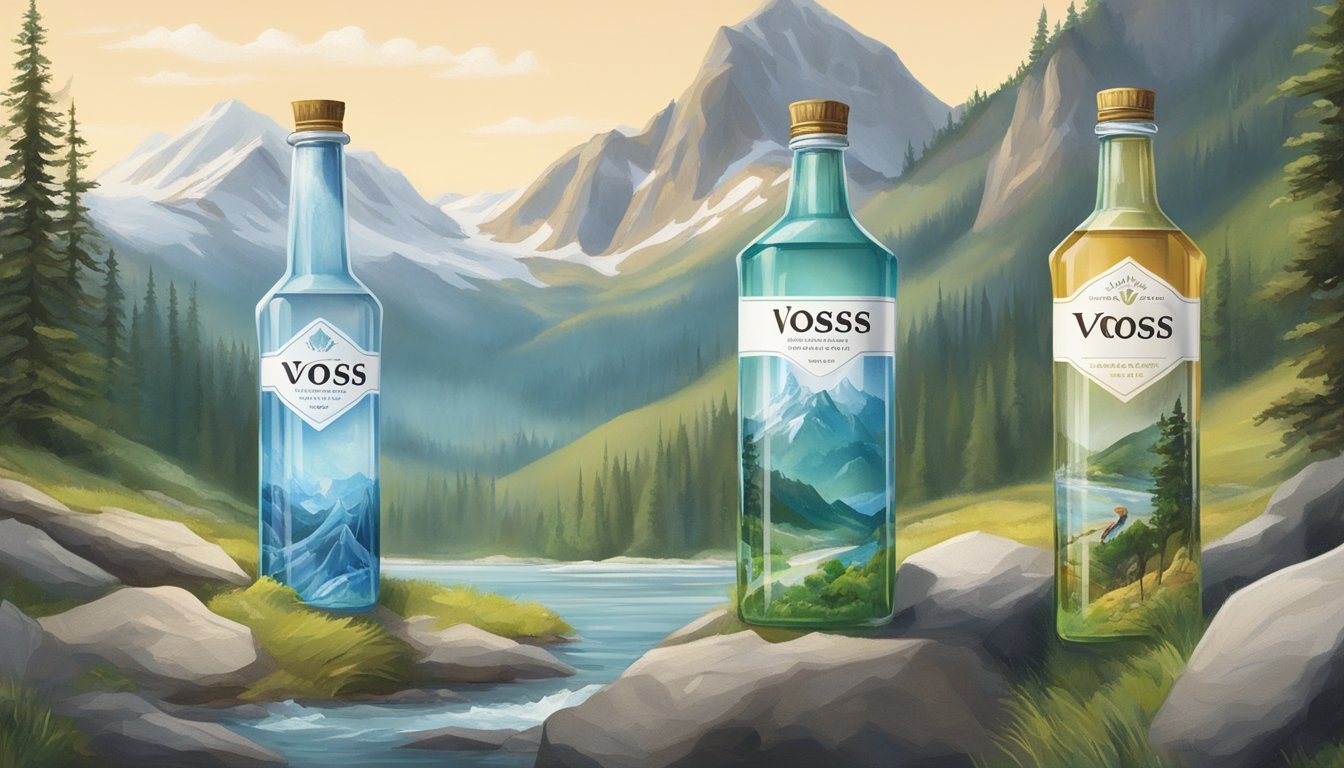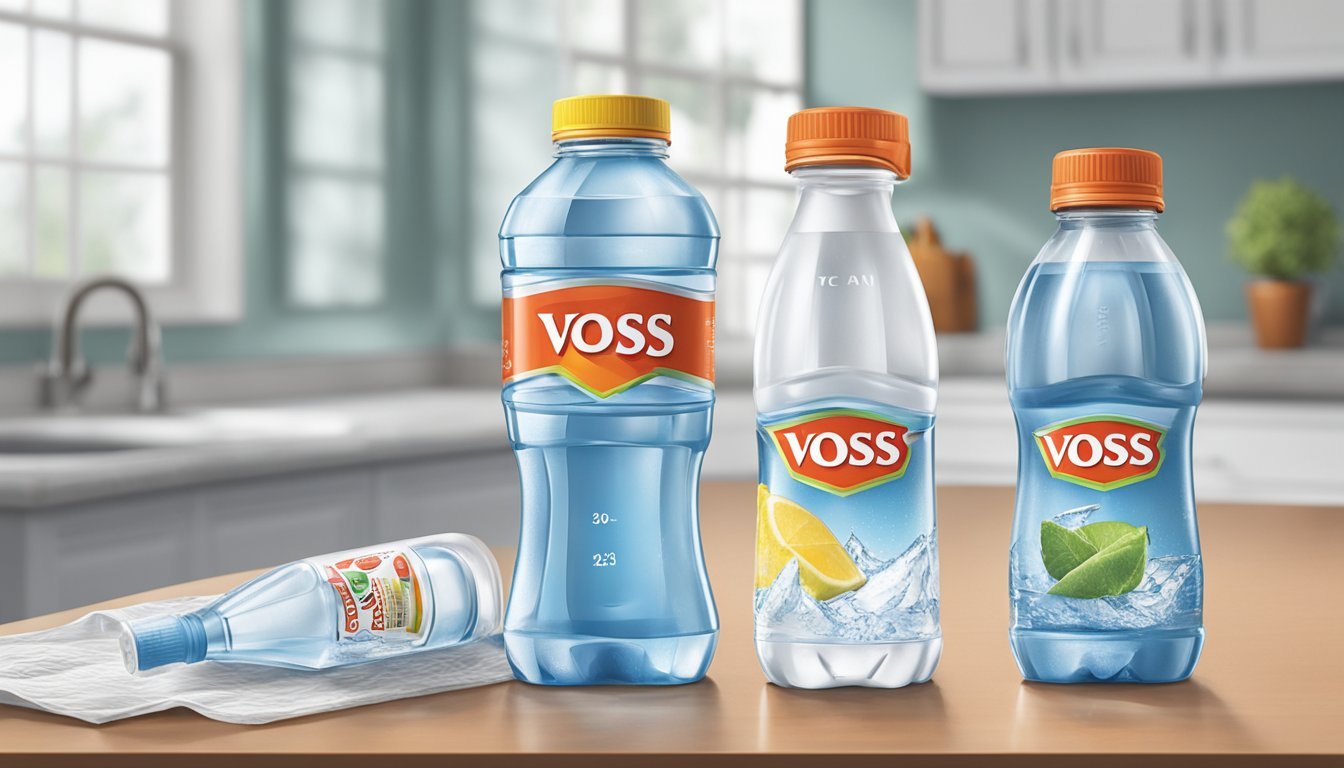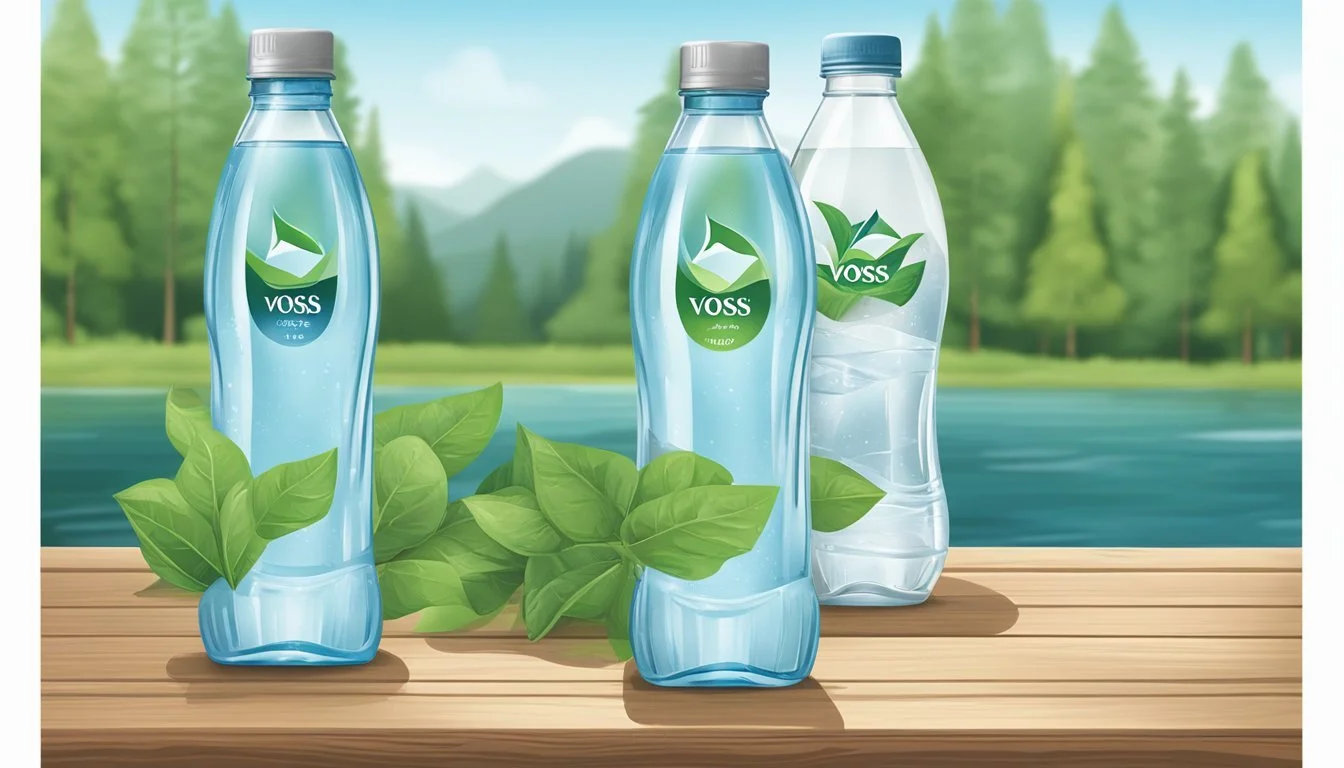Arrowhead vs. Voss
Comparing Quality and Taste in Bottled Water Brands
In the world of bottled water, where choices are abundant and brands claim various health benefits and sources of purity, consumers are often faced with the decision of which water to choose. Arrowhead and Voss represent two prominent names in the bottled water market, each with a distinct background and reputation. Arrowhead, sourced from mountain springs across the western United States and Canada, is known for its wide availability and approachable price point. It has been a staple in the American bottled water scene for many years, providing hydration that is described by reviewers as satisfactory but unremarkable.
On the other hand, Voss, with its sleek bottle design and Norwegian origins, touts a premium image that suggests a different level of quality. Sourced from an artesian well in Norway, Voss prides itself on the water's purity and taste, portraying a more upscale approach to bottled water consumption. Critics often regard Voss as more than just a refreshment, but a luxury product that offers a crisp taste with no aftertaste, ostensibly setting it apart from the numerous options on the market.
Both brands have carved out their own niches within the bottled water industry; however, the question persists: Which bottled water is better? To answer this, one must consider factors like taste, source, packaging, price, and environmental impact, all of which play significant roles in determining the preference of one brand over another. It is through these lenses that consumers can make an informed choice between Arrowhead's reliable accessibility and Voss's premium positioning.
History and Origin
When comparing bottled water brands like Arrowhead and Voss, understanding their historical backgrounds provides insight into their distinct characteristics and market presence.
Arrowhead Background
Arrowhead water traces its origins back to the Arrowhead Springs in the San Bernardino Mountains of California. The company, founded in the late 19th century, takes its name from the naturally occurring arrowhead-shaped rock formation in the mountains. Their water is sourced from multiple springs in the area, benefiting from the mineral-rich composition as it filters through volcanic rock.
Voss Beginnings
Voss, on the other hand, originates from the crisp, icy landscapes of Norway. The brand began bottling water in the early 2000s from an aquifer in the village of Vatnestrøm, shielded by layers of sand and gravel that have protected it for centuries. This natural filtration process contributes to the water's pure taste, and its origins in the untouched wilderness of Norway position it as a premium product. Voss water is also notable for its distinctive cylindrical glass bottle, a mark of its luxury branding.
Water Quality and Sources
In determining the superiority between Arrowhead and Voss bottled water, one must consider their water sources and quality. Various factors such as water type, mineral content, and purification methods play essential roles in defining the taste and health benefits of bottled water.
Spring Water Versus Artesian Water
Arrowhead derives its water primarily from spring water sources, sourcing from mountain springs across the western United States and Canada. Spring water is collected as it flows to the surface or via a borehole that taps into the underground source. Voss, on the other hand, boasts of its Fiji natural artesian water, originating from an artesian aquifer in Norway. Artesian water comes from a well tapping a confined aquifer where the water is under pressure, allowing it to rise above the level of the aquifer naturally.
Mineral Content Analysis
The mineral content of bottled water significantly affects its taste and health profile. Arrowhead Mountain Spring Water typically has varying levels of minerals depending on its source, while Voss water is known for its low mineral content, which gives it a clean and fresh taste. A comparative analysis might reveal:
Arrowhead: Calcium, magnesium, potassium, bicarbonates
Voss: Low levels of minerals, which contributes to its purity
Consumers often compare these brands to others like Evian, which is rich in minerals compared to typical municipal water.
Purification Process
Both brands entail distinctive purification processes. Arrowhead water may undergo filtration and ozonation before bottling. Voss, renowned for its purity, also likely uses mechanical filtration, ultraviolet light, and ozone treatment to ensure the water meets high sanitary standards. Unlike procedures such as reverse osmosis used for purified water, which strips away minerals along with contaminants, these processes are designed to maintain the natural composition of the water while ensuring safety and cleanliness.
Health and Hydration
When choosing between Arrowhead and Voss bottled waters, consumers often consider their health and hydration needs. Each brand offers distinct benefits concerning hydration benefits, electrolyte levels, and pH levels and acidity.
Hydration Benefits
Both Arrowhead and Voss bottled waters serve the primary function of hydrating the body. Arrowhead, sourced from mountain springs, provides natural hydration with a blend of trace minerals acquired from the spring water's journey through rock. Voss, originating from Norwegian artesian sources, delivers purity and hydration without the additives found in more processed waters.
Electrolyte Levels
Electrolytes are critical for proper hydration because they help regulate nerve and muscle function, balance blood acidity and pressure, and rebuild damaged tissue. While neither brand is marketed primarily as an electrolyte water, the mineral content inherent in both offers a natural electrolyte balance. Arrowhead contains naturally occurring electrolytes like calcium, magnesium, and potassium. Voss, on the other hand, is also known to contain minerals, but the specific electrolyte levels may vary depending on the source.
pH Levels and Acidity
The pH level of water can influence its taste and how it interacts with the body. Arrowhead water tends to have a pH that closely mirrors natural spring water, which can vary but generally hovers around neutral. Voss boasts a high pH level, often labelled as alkaline water, which some consumers prefer for its taste and potential health benefits. Alkaline water typically has a pH above 7, which is considered basic on the pH scale. Neither brand typically has added chlorine or fluoride, maintaining a natural mineral balance.
In conclusion, Arrowhead and Voss both offer hydrating options, with varying levels of electrolytes and differing pH balances, suited to individual preferences and needs.
Taste Profile
When evaluating bottled water, taste is a subjective yet crucial attribute. It encompasses the overall water taste, any aftertaste, acidity, and even how the water pairs with foods like coffee.
Arrowhead's Flavor
Arrowhead Mountain Spring Water is sourced from mountain springs across the western U.S. and Canada. Consumers often describe its taste as neutral and straightforward with a refreshing quality. However, some mention that Arrowhead lacks a distinctive taste profile—it's often referred to as average in comparison to other brands. There are no strong notes of minerality or a unique aftertaste that characterizes this water, making it a suitable accompaniment for everyday hydration rather than a specialty beverage.
Voss's Palette
Voss water, originating from the Norwegian wilderness, is praised for its clean and crisp taste, which can be attributed to the low mineral content. The water is also known for its lack of acidity, presenting a smooth and almost silky mouthfeel. Its taste profile is more notable and distinct, considered by water sommeliers to be the "cabernet of water" for its luxurious and rich character. Voss's pure flavor profile makes it an excellent choice for pairing with delicate dishes or enhancing the taste of fine coffee, as it does not overpower the palate.
Packaging and Environmental Impact
The packaging choices of bottled water brands directly influence their environmental footprint, with materials and production processes being key determinants.
Bottle Materials
Arrowhead uses PET plastic bottles, which are lightweight and recyclable, but if not properly disposed of, they can contribute to environmental pollution. The PET bottles are free from BPA, a chemical that once raised health concerns regarding its use in consumer products. On the other hand, Voss provides its water in high-quality glass bottles, which are also recyclable and can maintain purity of the water. Glass packaging has a longer recyclable life than plastic and is often perceived as more upscale.
Material Reusability Recyclability Notes PET Plastic Single-use High BPA-free, lightweight Glass Multi-use Very High Durable, maintains purity
Environmental Considerations
The production of bottled water, regardless of the brand, typically has a higher environmental impact compared to tap water. This impact includes CO2 emissions and energy consumption. Both Arrowhead and Voss need to consider the lifecycle of their packaging to minimize harm to ecosystems.
Arrowhead: Despite the recyclability of their bottles, the widespread use of plastic can lead to pollution if not properly managed. The brand can improve its environmental footprint by encouraging customers to recycle and by possibly exploring more eco-friendly packaging options such as boxed water.
Voss: Although glass bottles are inherently more environmentally friendly due to their reusability and recyclability, they are heavier than plastic, which increases shipping emissions. Voss can benefit the environment by promoting the reuse of their stylish glass bottles, encouraging the use of reusable bottles, or investing in lighter eco-friendly materials that maintain their brand's premium image.
Brand Presence and Public Perception
In the bottled water market, brand presence and public perception play pivotal roles in consumer choices. An examination of the marketing strategies and consumer trust levels for Arrowhead and Voss reveals distinct approaches by each brand to position themselves within the industry.
Marketing Strategies
Arrowhead, a brand under the Nestlé Waters North America umbrella, projects an image of being an everyday hydration option. Their marketing emphasizes the natural origins of the water, sourcing from mountain springs in the western United States and Canada. Arrowhead tends to utilize traditional advertising methods and is routinely available in grocery stores and conventional retail outlets.
In contrast, Voss positions itself as a premium water brand. Originating from Norway, Voss's marketing strategy leans heavily on the aesthetic of simplicity and luxury. Voss often partners with high-end venues and events to reinforce its elite status. Their packaging—a clear, cylindrical bottle—is immediately recognizable and stands out on shelves, aiding in brand recall.
Consumer Trust
The level of consumer trust varies remarkably between Arrowhead and Voss and generally reflects their respective marketing strategies. Arrowhead, while a widely recognized name, often garners mixed reviews regarding taste and consistency. This sentiment is echoed across several rankings of popular brands of bottled water. Due to its broad availability and association with a large conglomerate, Nestlé, some consumers perceive Arrowhead as a less exclusive choice.
Voss, however, benefits from the perception of offering the "best bottled water" experience due to its premium branding and higher price point. The association with luxury and a focus on quality often builds a higher level of trust among consumers who are willing to pay a premium. Yet, this perception limits Voss's accessibility to a market segment less sensitive to price.
Both Arrowhead and Voss navigate an industry dominated by heavyweights like Coca-Cola and PepsiCo, which also own popular bottled water brands. Voss and Arrowhead maintain their distinct brand presence by capitalizing on their unique marketing strategies and the level of trust they have cultivated among consumers.
Regulations and Standards
Bottled water companies, such as Arrowhead and Voss, are held to strict regulatory standards to ensure the quality and safety of their products. These standards pertain to both the quality assurance procedures that companies must follow and the environmental regulations set by governing bodies.
Quality Assurance
The Food and Drug Administration (FDA) mandates that bottled water must meet stringent quality standards, equivalent to those imposed on public water systems by the Environmental Protection Agency (EPA). For instance, Arrowhead, deriving water from the San Bernardino Mountains, must ensure that their water quality complies with FDA's standards. These standards cover a wide array of contaminants, including:
Microorganisms
Disinfectants
Disinfection byproducts
Inorganic chemicals
Organic chemicals
Radionuclides
FDA regulations stipulate that bottled water must be tested for these contaminants with a certified process. EPA sets the lead limit for tap water, while FDA enforces a thrice as stringent lead limit for bottled water. Organizations like the Environmental Working Group (EWG) keep tabs on both private and public water suppliers to inform consumers about any discrepancies in quality assurance.
Environmental Regulations
Bottled water producers must navigate environmental regulations concerning the sourcing and distribution of their product. Arrowhead, for example, has faced scrutiny regarding the sustainability of bottling water from springs in San Bernardino Mountains. Regulatory bodies are tasked with ensuring that corporations abide by environmental laws to preserve natural resources.
The environmental impact of water bottling activities includes:
Resource management: Ensuring that the extraction of water does not disrupt local ecosystems and water tables.
Packaging: Encouraging the use of recyclable materials to reduce waste.
Carbon footprint: Minimizing the transportation emissions involved with the distribution of bottled water.
Consumers often opt for products like Brita filters to reduce their environmental impact while ensuring water quality. Both companies and end-users are encouraged to adhere to guidelines that aim to balance quality assurance with environmental stewardship.
Comparative Cost Analysis
When comparing Arrowhead and Voss bottled water, cost plays a significant role in consumer choice. This section breaks down the price points and value for money of each brand to aid customers in making an informed decision.
Price Points
Arrowhead bottled water is typically considered a budget-friendly option. A standard 500 ml bottle can often be found in retail stores for approximately $1.00 to $1.50. In contrast, Voss is positioned as a premium brand with a 500 ml bottle's cost ranging between $2.50 and $3.50.
Volume Arrowhead (per 500 ml) Voss (per 500 ml) Single Bottle $1.00 - $1.50 $2.50 - $3.50 Bulk Purchase Lower per unit cost Higher per unit cost
Value for Money
Consumers often evaluate value for money based on their individual perception of quality versus cost. Arrowhead, being a widely available and affordable brand, provides functional hydration at a low cost. Voss, with its premium pricing, is marketed towards those looking for a luxury experience or those who prefer its taste or packaging aesthetics.
Arrowhead: High volume, lower cost — practical choice for daily consumption.
Voss: Lower volume, higher cost — seen as a luxurious option or status symbol.
It's important for consumers to consider their budget alongside their preferences for brand image, taste, and packaging when determining which bottled water offers better value for money.
Conclusion
Arrowhead and Voss represent two very different ends of the bottled water spectrum in terms of source, taste, and branding. Arrowhead, sourced from springs across the United States, offers a more natural and budget-friendly option. It's commonly found in supermarkets and is known for a taste that reflects its regional sources.
Voss, on the other hand, is often perceived as a premium brand. Originating from a Norwegian aquifer, Voss water carries a reputation for purity and is frequently marketed with high-end restaurants and hotels in mind. Its price point is typically higher than Arrowhead's, and the brand emphasizes the aesthetic appeal of its bottle design as part of its luxury image.
Taste Preference:
Arrowhead: Varied, depending on regional source; some reports of aftertaste.
Voss: Clean and crisp; often preferred by those seeking a "pure" water taste.
Cost Considerations:
Arrowhead: More budget-friendly; widely accessible.
Voss: Higher cost; positioned as a premium product.
Environmental Impact: Both brands should be consumed with a consideration of the environmental impact of bottled waters. The production and disposal of plastic bottles contribute significantly to environmental concerns. Glass bottles, as offered by Voss, may reduce some impact but still require energy to produce and recycle.
When choosing between Arrowhead and Voss, it ultimately comes down to personal preference and priorities. If one prefers a more affordable, everyday water with regional variety, Arrowhead is suitable. Consumers inclined towards a premium water experience, often for special occasions or for a taste of luxury, may lean towards Voss. It's vital for consumers to be informed about not only the taste and cost but also the environmental implications of their bottled water choices.










